Every Day as a
Days that Define
By Ron Scutt
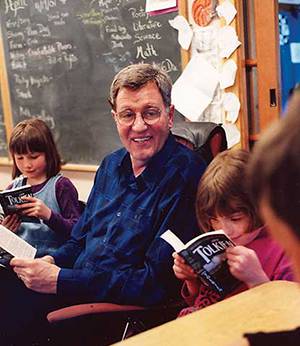
The Walk
Walking away from the dim glow of our porch light and up the road towards school, dark prevailed. The full moon’s light was obscured completely by a thick blanket of low clouds. Light snow fell invisibly. Singular sounds heard while walking along the dark road corridor were padded, muffled, calm.
I have walked early mornings when stars blaze brilliantly; when orderly constellations appear as predictable, comforting landmarks in the vast, vast reach of heaven. This dark December morning was the temporal antithesis counterbalancing those brilliant cold mornings when an immeasurable starry sky provides the wings to carry you up … up …up…

Promise of a Great Day to Come.
Today, in contrast, the snow laden clouds muted sounds below as equitably as they obscured the moon’s light above. This morning, no glance upward called to a soaring spirit. Today, all was close and personal.
The gently falling snow subdued virtually all vision. The road corridor was black; the forest bordering the road was black; upward was black; outward was black; backward was black. The sense of sight perceived no gracious light. The sense of sound, however, regaled with the opportunity to bestow its gifts. Stirrings in the moist early air seemed extraordinarily amplified possessing clarity, even unique personality. The river softly sizzled, as the hushed tread of boots padded a quiet cadence upon the thin white veneer of early morning snow. The quietly expectant morning sang a soft, sifting, snowy song. The solitary sounds of inhalation and exhalation provided gentle rhythmic accompaniment for this oh-so-close meander along the road to school.
Pausing in front of the Sherers’, I stopped and turned toward the river to pray. Later, eyes wide open, my gaze worked to stretch across the black river toward the dark mountain wall beyond. Slowly, the moon could be seen delicately emerging through the thinning covering of clouds. All felt centered, still, serene.
The morning air spoke of a good day to come. The focused thinking of the previous night concerning the children and the challenging work ahead, helped prepare an agenda for the demanding day. In the quiet darkness, I felt confident.
Arriving at school, the first job was to light fires in the basement furnace and classroom stove. Later, chalk in hand, I wrote notes on the blackboard announcing the day’s schedule and relevant thoughts from the previous night. My mind felt like a fine tempered substance reaching out to accomplish the work ahead. It would be a busy day. There was no time for wasted time – none – not a speck. A host of challenges and opportunities faced us just one week before performing the “Christmas Carol” for the community, and the last day of the semester. All who work with children know this is a heady, exciting time of year. There was, however, much work that needed to be accomplished before semester’s end and before the children began to walk through the door.
Students Arrive
Second grader, Ursula, arrived at seven, an hour early. This is a daily occurrence. She enjoys arriving early and accompanying her dad as he heads to work. Each morning she tries to sneak through the door to surprise me, and each morning, when I hear the door latch click faintly, I call, “Good morning, Ursula.”
“Oh, Mr. Scutt, you always hear me!” she exclaimed in a bemused manner. It is the game we play each day.
Ursula’s shedding of winter wear could be heard in the mud room before she was actually visible. Heaving off her bright winter coat and boots generated the “day has begun” sounds preceding her entry into the classroom. As she entered, I drank from the spring of fresh news she has stored in that place children’s stories accumulate. Ursula is a fount of conversation. She found me typing report cards with feet up across a desk, a bag of popcorn by my side, and seated in my big, black, comfortable chair. “Do you want me to read?” she asked expectantly. “Yes, and do you want some popcorn?” I replied closing the laptop and report card thoughts. She gladly accepted the popcorn; I gladly accepted the reading. For the next fifteen minutes, Ursula sat by my side and reads a good story, a mystery. We were both curious as to the outcome and just before we discovered what was hanging in the tree, Samantha, Gordy and Cailene tromped into school. Another burst of fresh, chilly air accompanied them through the door.
With more, “Good mornings,” Ursula’s reading ended and the school day began in earnest. She and I would return to the mystery later in the day. Right then we both wanted to greet the new arrivals. More stories, observations and thoughts poured like a warm heat into the room. Ursula’s reading ignited the educational engine; Samantha, Gordy and Cailene really started the motor revving and put us into gear. The school day began purring its rhythmic pulse. The light snow continued to fall peacefully beyond the windows in the dim morning light.
Ten minutes later, Quin, Clancy, Jena, Danita, Tyler and Ana arrived, bursting through the door with boisterous bluster. Clancy, a fourth grader, walked in carrying two huge, dirty, black, truck inner tubes draped over her arm, and a white sack filled with tire patching paraphernalia clutched in her hand. “May I patch the tires?” she asked rounding the corner of the sink hallway. “Yes,” I replied as my hands stretched towards her to open the bag and get started. Even though I heard the words, “May I patch the tires?” I wasn’t aware of the length
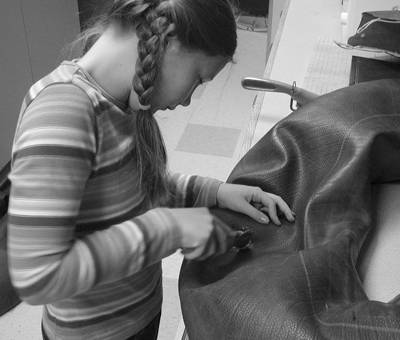
Clancy Fixing
and breadth of her serious intentions. Talking with her about how to tackle the patching problem, it became obvious that Clancy was prepared to patch these two huge tubes on her own. I removed my hands from the project and let Clancy begin the patching process. She was prepared and determined.
A host of challenges faced us one full week before the play and the end of school for the semester. Patching the truck tire tubes was one of those lingering yet-to-be-finished-jobs that had been hanging around awaiting closure. We use three truck tire tubes for sledding down the school hill at recess. Two of the tubes sported significant punctures. I talked to the class on previous days about the need for patching material. Only Clancy came with the tools prepared to do the job. She asked her dad for patches, patching equipment and instructions as to how to make repairs.
I watched with great respect as Clancy deftly found the holes, prepared the punctured spots, applied glue, waited five minutes for the drying process to take place, applied the patches and used the roller to secure them to the tubes. She was focused and serious about her work. Her fingers labored with nimble confidence. As other students played raucously in the motion room, Clancy repaired the sledding tubes with a concentration that belied characterizations of her age and gender.
While I watched Clancy work, Dylan, Will and Mary quietly entered school. Dylan and Will were still riding bikes on the snowy road to get to school. Mary arrived with her mom and wore a big first grader smile as she came through the door. Readiness teacher’s aid, Kim, also arrived with a cheery smile. She gathered up math papers to be checked and then headed to the Readiness Room to check papers and prepare for Ana. First grader, Warren, burst through the door just before eight like an exhilarated exclamation mark at the end of an energetic compound complex sentence. Each morning Warren comes through the door filled with abundant energy, ready to play and work. With Warren’s entry, the day officially began as we gathered in the Motion Room in a circle to recite the morning verse. We turned the lights out and placed a lit candle in the center of our circle. The candlelight in the motion room has a calming effect on all of us.
December Verse
Is this the darkest season of the year,
Or one of light, and love, and cheer?
Will the freezing cold of Winter’s night,
Break the Spirit’s Will?
Or will internal light grow bright,
Thawing Winter’s chill?
Let’s find a tree, an evergreen,
Add lights and tinsel,
Make it gleam.
And a silver star we’ll put on top;
Let’s get ready for Santa’s stop.
Everyone is rushing, going so fast.
Making presents, sending cards,
Will the time last?
…but, …oh, …how, …slowly, …time, …seems, …to, …pass.
“Quiet! Listen! What’s that sound I hear?
Could that be Santa’s sleigh drawing near?
I know I should sleep, but sleep won’t come.
I’ll stay awake until the dawn!”
Listen to the songs of peace and calm,
Close your eyes, it won’t be long.
Drift away on angels’ wings,
In this season, our Spirit sings.
Good Morning
Ending the verse, we hold hands in a circle and greet one another and the day. Often we will stay in the circle and sing or talk about the day to come, but this morning the students filed into the Main Classroom prepared for morning sharing. On this particular morning, however, little time was available for sharing. We had much to do.
Hauling the Stage
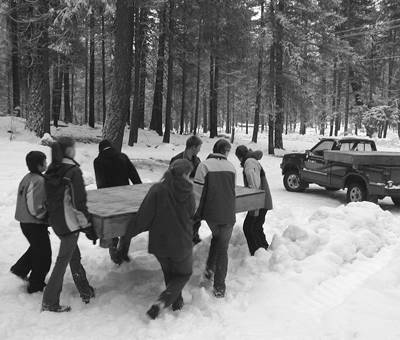
Stage Hauling
School custodian and friend, David Kurth, and I talked the previous week about moving the ponderous wooden stage sections from the old school, where they were stored, down to the new school for the upcoming play. David and I intended to move the stage sections later in the day, after school. The planning of the previous night, however, led me to believe that moving these stage sections while the older students were in school would be far better than David and me hauling them by ourselves. After a bit of sharing, I told the older students to jump in the truck and we drove to the old school while Kim stayed with the younger students and practiced lines and movement for the upcoming play. Always happy for diversions, the older students complied in good humor.
The stage sections are constructed of massive rough cut lumber and thick plywood. Each section measures four by eight feet. They are stored in the woodshed behind the old school with an accumulation of other chaotically placed, used-once-a-year (or once a decade) equipment. As luck would have it, the stage sections could not be moved until all the other stored paraphernalia was removed from the shed. Working together, this task was accomplished rather quickly. Now, the heavy lifting could begin.
Positioning ourselves awkwardly in the cramped shed, three of us pushed, pulled, prodded, nudged and generally cajoled the unwieldy piece through the narrow woodshed door where other eager hands reached to assist. It should be noted that the distance between the truck parked in front of the old school and the woodshed behind the school was covered with snow two feet deep. We placed the stage section on the snow like a stretcher, distributed ourselves around it and prepared to lift. I told the students, “Now, I don’t want anyone getting hurt. We will count to three and lift together. Are you ready?” Everyone nodded in the affirmative. “Alright, ready – one, two, …” Before the word “three” ever left my mouth, the section lifted off the snow as if by effortless magic. The students laughed as I stared at them in a bemused manner; so much for establishing a cadence.
We were all surprised how light the stage section felt with all of us supporting the weight. Traversing the distance between the back of the school and the truck with the heavy section was, however, not effortless. Snow that plummeted from the steep, cedar shake school roof made walking difficult. Then, climbing over the berm, created by the grader clearing the old school parking area, provided an interesting obstacle as students suddenly stumbled and disappeared from sight beneath our heavy load. It seemed that for all of the falling and flailing, there were always enough able arms to hold the stage in the air.
After crossing the berm in front of the school, we lifted the section and placed it on the truck so it straddled the bed – one down; more to go. We tromped back through the snow to retrieve the second section. With each section we reclaimed from the shed, our labor became more arduous. No one complained of being cold; we were heated from the exertion. Reaching the truck with the third section, I told the students to climb on the back and to sit on the sections as we drove slowly back, down the hill, to school. All went well and the students conducted themselves maturely as they sat on the wide wooden platforms being carried down the road just as dreamily as if they were riding Tom and Huck’s raft down the Mississippi.
If loading the stage sections onto the truck had been difficult, unloading the sections and carrying them into the school offered no easy respite. Once again we had to peg leg through snow behind the new school, lift the sections over a drift of snow by the back door, and haul them through the Readiness Room into the motion room. Entering the school through the back door, we saw the younger students hurtling around the Motion Room at varying velocities. They were exuberant. While we were gone, they had practiced their parts repeatedly (the Cratchits and street children) and were now excited to the point of bursting as we wrestled THE STAGE! into the Motion room. It must have seemed to them like the final pieces were fitting together for the “Christmas Carol,” and that the play they had pictured in their minds so often in recent weeks was really coming into being – substantial, tangible. As we brought each stage section into the Motion Room, the little ones would jump to the stage and begin speaking lines from the play. They were able to recite not only their lines, but also those of Scrooge, Bob Cratchit, the Matrons, Marley and all the other characters of the play. As young minds are capable, they absorbed far more than their own meager lines while practicing and listening to other characters. The younger children were animated as they bounced buoyantly, reenacting scene after scene as we lumbered into the room with yet another stage section. It took fifteen to twenty minutes to bring all three sections into the Motion Room and put them into place. All in all, I knew this first activity of the morning was beneficial for all of us. Working together to successfully achieve a practical task always feels good.
Community Helpers
When we reentered the main classroom to resume the course of the day, Renee Hudak, our School Board Chair and mother of Ursula, was on hand to talk about the art of India as a corollary study to our reading the Jungle Book by Rudyard Kipling. Renee came into the classroom with baby Nora on her hip and pictures of Indian art in her hands. She also brought clay with her to use with a project she had planned. It was a pleasant hour we spent, as groups studied a variety of pictures trying to make sense of the creative work from a distant culture. We talked of Indian fables and the fact that India has a festival of light at approximately the same time we celebrate Christmas.
The review of Indian art was followed by shaping small clay lamps that would hold oil and a wick. Seeing busy work with concentration to shape individually unique urns was a soul satisfying experience. There was a tangible calm that permeated the room as young fingers practiced the art of shaping small bowls. Quiet conversation meandered through the room as hunks of clay were formed into lamps similar to those that might be used in India. Time passed almost without notice as we drifted towards snack time engaged in this practical artistic labor.
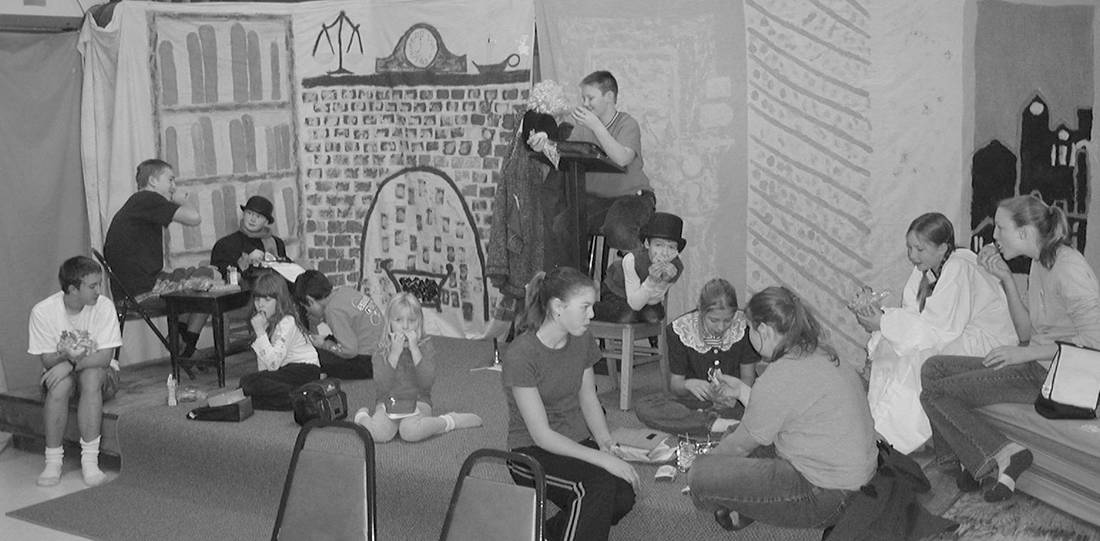
Snack Time on the Set
At precisely 10:30, snack time sauntered its way on the school scene like a friendly giant, and this particularly busy morning offered no deviation from this hallowed break in the day. Snack time is generally viewed as a fifteen minute island of unmitigated pleasure surrounded by a sea of academic, artistic and physical responsibility. Students entered the motion room sporting various containers filled with tantalizing snacks. Choice spots were converged upon quickly. Everyone found a comfortable place to sit and eat in earnest. Today, sitting on the stage, the children formed themselves into smaller cohesive units of mastication and conversation. Some sat in Scrooge’s bedroom; others gathered round the Cratchit’s dinner table. There was even room for one student on Bob Cratchit’s office stool. Everyone found a comfortable spot with friends. Easy conversation was interrupted frequently while desserts were traded and chips bartered. Like the proverbial grass that is greener on the other side of the fence, a neighbor’s treats are often more coveted than one’s own. The snack economy is driven by hungry eyes and activated taste buds.
The fifteen minutes devoted to snacks flew by in an instant and it was time to reenter the classroom.
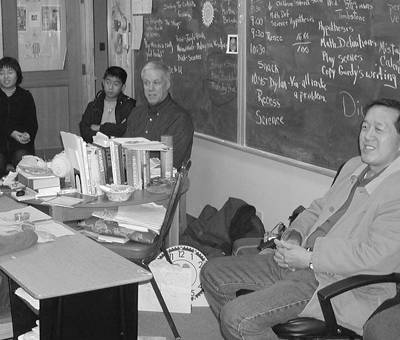
Jean Jin, Sven Chen
Today, valley residents, Vince and Norma Ward, were visiting the school with friends, the Lee family, from Malaysia. Vince, who traveled in Malaysia extensively before retiring, asked if the Lees could visit the school while they were in the valley. I was happy to accommodate this type of visit as it helps make this isolated school setting suddenly cosmopolitan. Like clockwork, the Lees, Vince and Norma entered the school at 10:45. They sat in chairs in front of the room while Vince and Norma made introductions. For the next forty-five minutes, the class was transported to a dissimilar place where monsoons are a way of life as is sugar cane production, Ramadan, and a host of unique customs different than our own. Celebrations of birthdays were discussed. Eating habits were compared. We learned of different styles of clothes and about the agricultural production of Malaysia. We found Malaysia on the globe and talked about life near the equator. Once again, time flew by as we listened to stories about this distant culture.
Recess and sledding at 11:30 that transported sixteen year old, Jean Jin, and twelve year old, Sven Chen, into a snowy scene of bliss. They became totally absorbed in a particular characteristic of our culture that delighted them. As Vince, Norma and Mr. and Mrs. Lee headed out to the sledding hill with the children, I tidied up things in the room and watched out the window. Jean Jin and Sven Chen joined right in with the students grabbing the repaired inner tubes and sleds and heading for the sled hill. Up the hill they went, encouraged by all the students. Soon everyone, young and old, Malaysian and American, leaped on sleds and tubes and hurtled down the icy hill together,
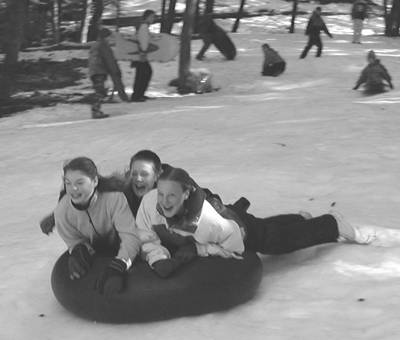
Tubing
ending in a snowy mosh pit of laughing bodies at the bottom. Seeing the fun, I put snow gear on and headed for the hill. Joining the elders, I watched as all the students headed to the top again and began their plummet down the snowy slope. The smiles on the faces of the sledders could not have been more expressive. Stehekin students encouraged their guests wholeheartedly. The students offered me one of the tubes and I joined them at the top of the hill. Sliding down the hill I, too, shouted gleefully as I picked up speed and headed for the big bumps at the bottom of the hill.
I was impressed by the Malaysian children’s willingness to join our children with such enthusiasm. They held back not one iota. Hurtling down the hill and tramping back up again consumed over a half hour before the Lee’s had to leave the sledding hill to get ready to take the boat downlake. With honest and enthusiastic “goodbyes,” they headed out with Vince and Norma. How impressive it was to see all the children get along so well and to see such unpretentious, candid smiles on the faces of our guests. Joy shared by children is one of the universal elements that hold mankind together. The sledding inspired the following writing:
Galaxy of Glee
Pouring,
rolling,
cascading,
hurtling,
rocketing
down
iced
hills
bright beings cling to twirling tubes,
filling the narrow forest trail
like laughter filled suns
squealing in a galaxy of glee.
The children and I continued sledding for the rest of the recess. We all returned to the classroom at 12:30, our bodies steaming vapors from the wet and wonderful exertion.
(Later, we received a card from Norma and Vince who wrote: “Thank you so much for being so kind to our friends from Malaysia. They were so happy to see your school. They kept saying, ‘It’s so free! It’s so free!’ No wire fences, no brick walls, no guards. The sledding was their favorite.” As I read the note to the class, I could not help think that the “freedom” they expressed came from other points on Liberty’s compass as well. The attempt to address the sense of “freedom” witnessed by the Lee children will have to wait until I am able to articulate it more precisely.)
Science
Animated chatter filled the mudroom as wet snow pants, coats and gloves were hung over the clothesline or placed on the heating ducts. Surveying the children while tugging at my own wet snow gear, it seemed I was observing a harvest of hearty health. Red cheeked children entered the classroom with wet hair skewed on their heads at rakish punk-a-do angles. Wide smiles filled faces. Some sat at desks looking at the board to see what was next on the schedule while others gathered around the stove to warm their hands and exchange sledding stories. Those looking at the board saw that Dick Bingham was coming in for a science lesson that afternoon.
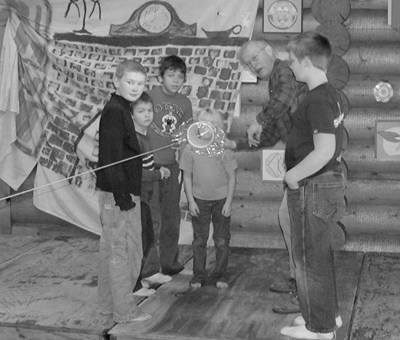
Dick and budding scientists
Dick, a retired engineer for the Hewlett Packard Company, is a Stehekin resident. His intellectual loves are the study of electrical engineering, and his amateur radio equipment. Dick works with the students on Wednesday afternoons. After warming themselves by the fire, the students prepared for Dick’s arrival by practicing the Morse code. Eighth grader, Dylan, sat in front of the class and tapped out letters and words on our telegraph key. The rest of the class sat at their desks deciphering Dylan’s messages. Dick entered the room quietly as Dylan completed his work. Today Dick’s goal was to build a tin can telephone similar to those I made in my youth. Dick has been working with the class throughout the year trying to make the concept of sound waves become visible. Today he used simple equipment. Stretching a thin string between two cans from the classroom to the Motion Room, the students took turns listening and speaking into the crude telephone system. The time flew past.
The day, as full as it had been, seemed a blur as the science lesson drew to a close and it was time for dismissal. Amidst animated chatter, the students stood behind their desks waiting for me to arrive and shake their hands before they headed to the mud room to don winter gear for their trip home. With a few words for each student, I worked my way around the room saying goodbye and thanking students for various contributions during the day.

Walking Home
Walking Home
Walking out the door, we saw Stehekin School graduate, Reed Courtney, waiting for us in the school parking lot. Earlier in the week I asked Reed if he could help David and me move the stage sections after school. True to his word, Reed was waiting ready to begin the laborious hauling. I am sure he was not displeased to find we had already moved three sections that morning. Rounding up a few older students, we headed to the old school to obtain the last two. With Reed helping, we loaded them with little difficulty and finished the job in a half an hour.
The school day, Wednesday, December 10th, was officially complete. Heading home with a cheery heart, the morning’s solitary darkness was transformed by brilliant blue skies which hinted at a “constellation morning” to come. Reed drove me home from school. We exchanged pleasant conversation. Getting out of his car I could not help but shake my head in awe as I reflected back on the day that offered such abundance of goodwill.
Our day was incredibly busy! …and yet it was incredibly orderly and valuable. There was no wasted time. The day was filled with projects and the loving attention of adults assisting with the learning process. Practical work was accomplished. The children exhibited the great potential of youth. Throughout the day they were orderly, attentive, curious, mannerly, helpful, comradely, equitable, tolerant and joyful. All in all, I had the feeling that it just doesn’t get any better. The children have good and loving hearts. The adults working with the children deliver gifts of knowledge with loving warmth and enthusiasm. December 10th was a joyous day to be alive!
There are days that define; days that, because of their character, impress the soul with the righteous stamp of – “Good tidings to all.” Today was such a day.
